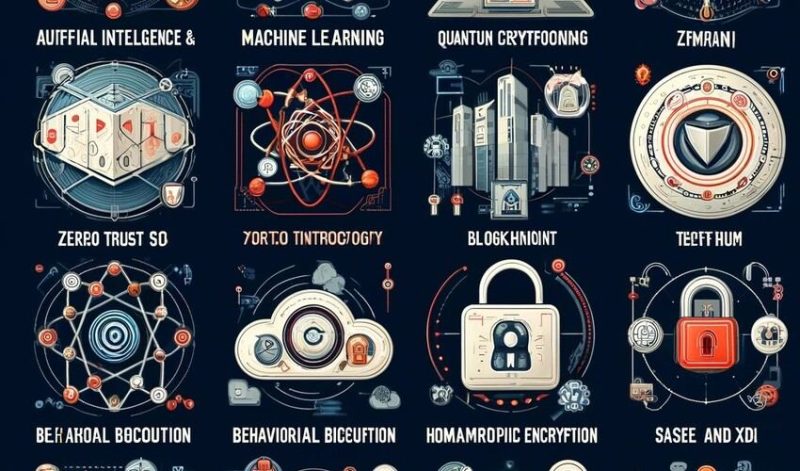As we venture into 2024, the digital landscape continues to evolve, bringing new opportunities and challenges. Among the most pressing concerns for businesses and individuals alike is data protection. Cyber threats are becoming increasingly sophisticated, and traditional security measures are insufficient. Cybersecurity innovations are emerging to address these challenges and safeguard sensitive information. This article explores the most cutting-edge cybersecurity innovations of 2024, highlighting how they protect your data.
The Need for Advanced Cybersecurity Innovations
Cybersecurity is the practice of defending computers, servers, mobile devices, electronic systems, networks, and data from malicious attacks. As cybercriminals become more adept at exploiting vulnerabilities, the need for advanced cybersecurity innovations has never been more critical. These innovations aim to anticipate, detect, and mitigate cyber threats, ensuring the integrity and confidentiality of data.
Top Cybersecurity Innovations in 2024
1. Artificial Intelligence and Machine Learning
Artificial Intelligence (AI) and Machine Learning (ML) are at the forefront of cybersecurity innovations. These technologies enable the development of advanced security systems to learn from past incidents and adapt to new threats.
How AI and ML Enhance Cybersecurity:
- Threat Detection: AI algorithms can analyze vast amounts of data to identify patterns and detect anomalies that may indicate a cyberattack.
- Predictive Analysis: ML models can predict potential vulnerabilities and recommend proactive measures to prevent breaches.
- Automated Response: AI-driven systems can respond to threats in real time, mitigating damage before it escalates.
2. Zero Trust Architecture
The Zero Trust Architecture (ZTA) model operates on the principle of “never trust, always verify.” It assumes that threats can come from outside and inside the network; thus, no user or device is trusted by default.
Key Components of Zero Trust:
- Identity Verification: Continuous authentication of users and devices.
- Least Privilege Access: Users are granted the minimum level of access necessary to perform their tasks.
- Micro-Segmentation: Dividing the network into smaller segments to limit the lateral movement of attackers.
3. Quantum Cryptography
Quantum Cryptography leverages the principles of quantum mechanics to create virtually unbreakable encryption methods. This innovation is essential for securing data against future quantum computing threats, possibly rendering current encryption methods obsolete.
Advantages of Quantum Cryptography:
- Quantum Key Distribution (QKD): Enables the secure exchange of encryption keys, detecting eavesdropping attempts.
- Unbreakable Security: Utilizes quantum entanglement and superposition to ensure data confidentiality.
4. Blockchain Technology
Blockchain technology offers a decentralized and tamper-proof way to secure data transactions. While it is commonly associated with cryptocurrencies, its applications in cybersecurity are expanding.
Applications of Blockchain in Cybersecurity:
- Data Integrity: Blockchain’s immutable ledger ensures that data cannot be altered once recorded.
- Secure Authentication: Decentralized identities and blockchain-based authentication mechanisms enhance security.
- Smart Contracts: Automate and secure business processes without the need for intermediaries.
5. Behavioral Biometrics
Behavioural biometrics analyze patterns in user behaviour to authenticate identities. Unlike traditional biometrics (fingerprints, facial recognition), behavioural biometrics focuses on user interaction with devices.
Examples of Behavioral Biometrics:
- Keystroke Dynamics: Analyzing typing patterns to verify identity.
- Mouse Movements: Monitoring how a user moves the mouse.
- Touchscreen Interactions: Evaluating how a user interacts with touchscreens.
6. Homomorphic Encryption
Homomorphic encryption allows data to be encrypted and processed without being decrypted. This means computations can be performed on encrypted data without exposing it, significantly enhancing data privacy.
Benefits of Homomorphic Encryption:
- Enhanced Privacy: Sensitive data remains encrypted during processing.
- Secure Cloud Computing: Enables secure data processing in cloud environments without compromising privacy.
7. Secure Access Service Edge (SASE)
Secure Access Service Edge (SASE) is a framework that combines network security and wide-area networking capabilities into a single cloud-delivered service model. It addresses the security needs of remote and hybrid workforces.
Core Components of SASE:
- SD-WAN: Provides secure and optimized connectivity.
- Cloud Security: Includes secure web gateways, cloud access security brokers (CASB), and firewall-as-a-service (FWaaS).
- Zero Trust Network Access (ZTNA): Enforces strict access controls.
8. Extended Detection and Response (XDR)
Extended Detection and Response (XDR) integrates data from multiple security products into a cohesive platform. It provides a unified threat detection and response approach across an organization’s entire security stack.
Advantages of XDR:
- Comprehensive Visibility: Offers a holistic view of security threats.
- Streamlined Response: Enhances efficiency in threat detection and mitigation.
- Improved Correlation: Correlates data from various sources for better threat analysis.
The Importance of Cybersecurity Innovations
The rapid pace of technological advancement necessitates continuous innovation in cybersecurity. As cyber threats evolve, so must the strategies and technologies used to combat them. Cybersecurity innovations are not just about keeping up with threats but about staying ahead.
Enhancing Data Protection
The primary goal of cybersecurity innovations is to protect data. With the proliferation of data breaches and cyberattacks, ensuring data confidentiality, integrity, and availability is crucial. Innovations like quantum cryptography and homomorphic encryption are particularly valuable in safeguarding sensitive information.
Facilitating Regulatory Compliance
Regulatory compliance is a significant concern for businesses, especially those handling sensitive data. Cybersecurity innovations help organizations comply with GDPR, HIPAA, and CCPA regulations by providing robust data protection measures and ensuring transparent data handling practices.
Building Trust with Customers
Trust is a valuable commodity in the digital age. By implementing cutting-edge cybersecurity solutions, businesses can demonstrate their commitment to protecting customer data and building trust and loyalty. This trust can translate into a competitive advantage, as customers are likelier to engage with businesses that prioritize their data security.
Conclusion
As we navigate through 2024, the importance of robust cybersecurity cannot be overstated. The cybersecurity innovations discussed in this article represent the cutting edge of data protection technology, offering advanced solutions to combat an ever-evolving threat landscape. These innovations, from AI and machine learning to quantum cryptography and blockchain, pave the way for a safer digital future. By staying informed and adopting these technologies, businesses can ensure their data remains secure, their operations uninterrupted, and their reputations intact.
Zainab Afzal is a senior SEO Consultant and Writer. She has 5+ years of experience in Digital Marketing. After completing his degree in BS computer science, she has worked with different IT companies.





